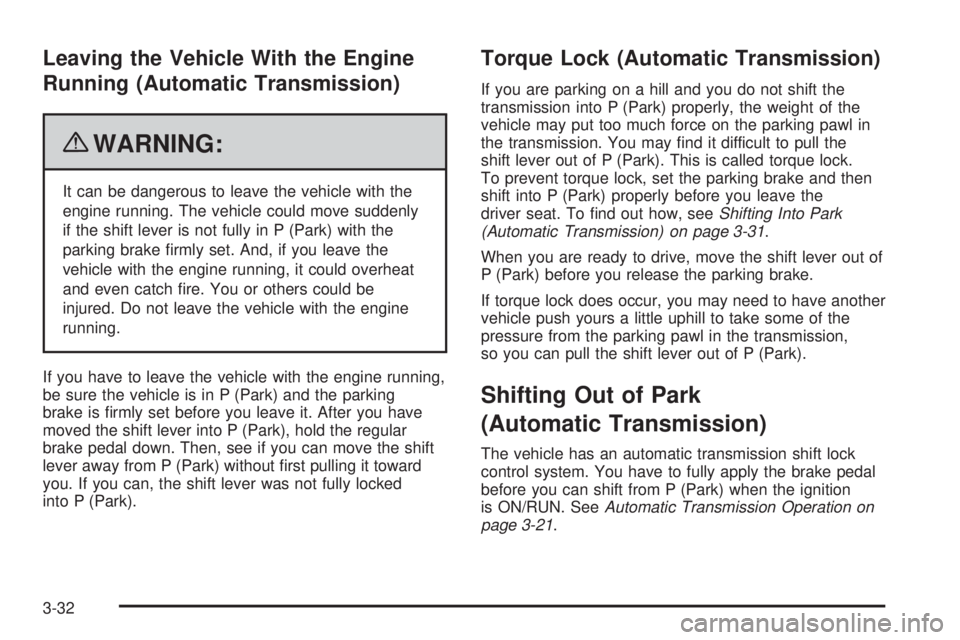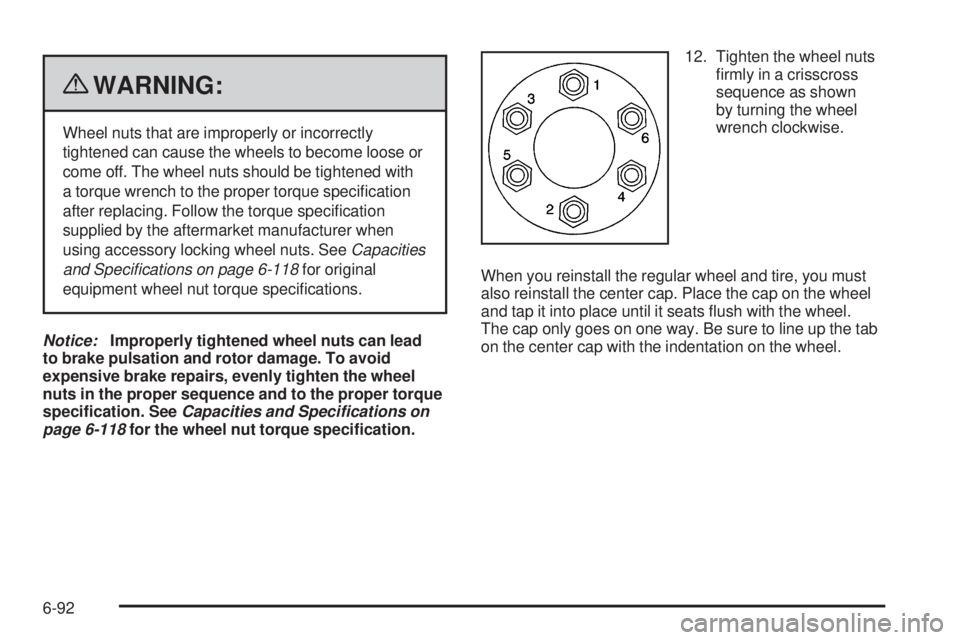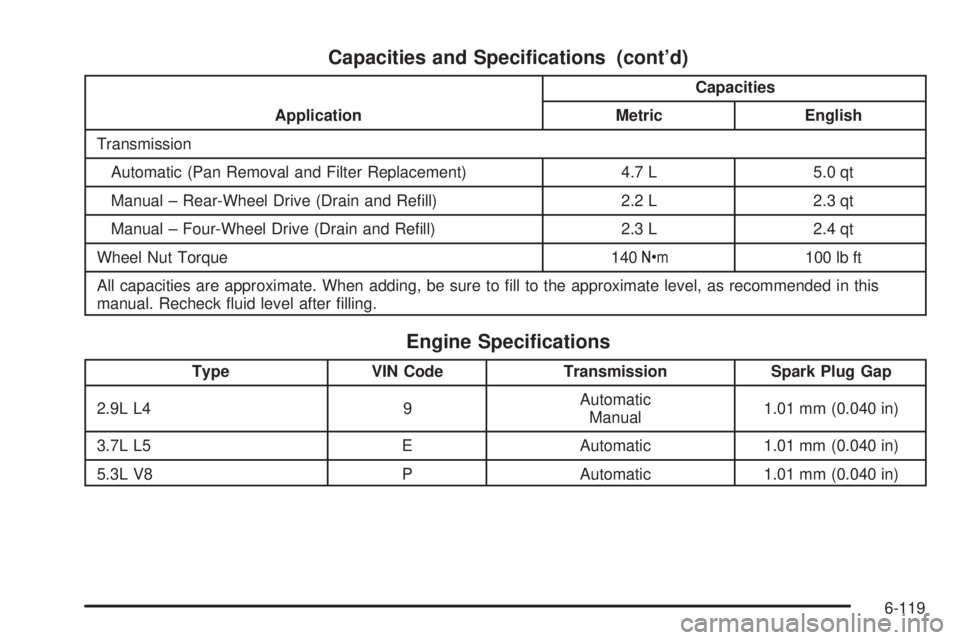2010 GMC CANYON torque
[x] Cancel search: torquePage 142 of 448

Leaving the Vehicle With the Engine
Running (Automatic Transmission)
{WARNING:
It can be dangerous to leave the vehicle with the
engine running. The vehicle could move suddenly
if the shift lever is not fully in P (Park) with the
parking brake firmly set. And, if you leave the
vehicle with the engine running, it could overheat
and even catch fire. You or others could be
injured. Do not leave the vehicle with the engine
running.
If you have to leave the vehicle with the engine running,
be sure the vehicle is in P (Park) and the parking
brake is firmly set before you leave it. After you have
moved the shift lever into P (Park), hold the regular
brake pedal down. Then, see if you can move the shift
lever away from P (Park) without first pulling it toward
you. If you can, the shift lever was not fully locked
into P (Park).
Torque Lock (Automatic Transmission)
If you are parking on a hill and you do not shift the
transmission into P (Park) properly, the weight of the
vehicle may put too much force on the parking pawl in
the transmission. You may find it difficult to pull the
shift lever out of P (Park). This is called torque lock.
To prevent torque lock, set the parking brake and then
shift into P (Park) properly before you leave the
driver seat. To find out how, seeShifting Into Park
(Automatic Transmission) on page 3-31.
When you are ready to drive, move the shift lever out of
P (Park) before you release the parking brake.
If torque lock does occur, you may need to have another
vehicle push yours a little uphill to take some of the
pressure from the parking pawl in the transmission,
so you can pull the shift lever out of P (Park).
Shifting Out of Park
(Automatic Transmission)
The vehicle has an automatic transmission shift lock
control system. You have to fully apply the brake pedal
before you can shift from P (Park) when the ignition
is ON/RUN. SeeAutomatic Transmission Operation on
page 3-21.
3-32
Page 317 of 448

Brake Wear
This vehicle has front disc brakes and rear drum
brakes.
Disc brake pads have built-in wear indicators that make
a high-pitched warning sound when the brake pads are
worn and new pads are needed. The sound can come
and go or be heard all the time the vehicle is moving,
except when applying the brake pedal firmly.
{WARNING:
The brake wear warning sound means that soon
the brakes will not work well. That could lead to an
accident. When the brake wear warning sound is
heard, have the vehicle serviced.
Notice:Continuing to drive with worn-out brake
pads could result in costly brake repair.
Some driving conditions or climates can cause a brake
squeal when the brakes are first applied or lightly applied.
This does not mean something is wrong with the brakes.Properly torqued wheel nuts are necessary to help
prevent brake pulsation. When tires are rotated, inspect
brake pads for wear and evenly tighten wheel nuts
in the proper sequence to torque specifications
inCapacities and Speci�cations on page 6-118.
Rear drum brakes do not have wear indicators, but if you
ever hear a rear brake rubbing noise, have the rear brake
linings inspected immediately. Also, the rear brake drums
should be removed and inspected each time the tires are
removed for rotation or changing. When you have the
front brake pads replaced, have the rear brakes
inspected, too.
Brake linings should always be replaced as complete
axle sets.
Brake Pedal Travel
See your dealer/retailer if the brake pedal does not
return to normal height, or if there is a rapid increase in
pedal travel. This could be a sign that brake service
might be required.
Brake Adjustment
Every brake stop, the brakes adjust for wear.
6-41
Page 348 of 448

Make certain that all wheel nuts are properly
tightened. See “Wheel Nut Torque” under
Capacities and Speci�cations on page 6-118.
{WARNING:
Rust or dirt on a wheel, or on the parts to
which it is fastened, can make wheel nuts
become loose after time. The wheel could
come off and cause an accident. When you
change a wheel, remove any rust or dirt from
places where the wheel attaches to the
vehicle. In an emergency, you can use a cloth
or a paper towel to do this; but be sure to use a
scraper or wire brush later, if needed, to get all
the rust or dirt off. SeeChanging a Flat Tire on
page 6-80.
Make sure the spare tire is stored securely.
Push, pull, and then try to rotate or turn the tire.
If it moves, tighten the cable. SeeStoring a Flat
or Spare Tire and Tools on page 6-96.
When It Is Time for New Tires
Various factors, such as maintenance, temperatures,
driving speeds, vehicle loading, and road conditions,
influence when you need new tires.
One way to tell when it is
time for new tires is to
check the treadwear
indicators, which appear
when your tires have
only 1/16 inch (1.6 mm)
or less of tread remaining.
Some commercial truck
tires may not have
treadwear indicators.
6-72
Page 368 of 448

{WARNING:
Wheel nuts that are improperly or incorrectly
tightened can cause the wheels to become loose or
come off. The wheel nuts should be tightened with
a torque wrench to the proper torque specification
after replacing. Follow the torque specification
supplied by the aftermarket manufacturer when
using accessory locking wheel nuts. SeeCapacities
and Speci�cations on page 6-118for original
equipment wheel nut torque specifications.
Notice:Improperly tightened wheel nuts can lead
to brake pulsation and rotor damage. To avoid
expensive brake repairs, evenly tighten the wheel
nuts in the proper sequence and to the proper torque
speci�cation. SeeCapacities and Specifications on
page 6-118for the wheel nut torque speci�cation.12. Tighten the wheel nuts
firmly in a crisscross
sequence as shown
by turning the wheel
wrench clockwise.
When you reinstall the regular wheel and tire, you must
also reinstall the center cap. Place the cap on the wheel
and tap it into place until it seats flush with the wheel.
The cap only goes on one way. Be sure to line up the tab
on the center cap with the indentation on the wheel.
6-92
Page 395 of 448

Capacities and Speci�cations (cont’d)
ApplicationCapacities
Metric English
Transmission
Automatic (Pan Removal and Filter Replacement) 4.7 L 5.0 qt
Manual – Rear-Wheel Drive (Drain and Refill) 2.2 L 2.3 qt
Manual – Four-Wheel Drive (Drain and Refill) 2.3 L 2.4 qt
Wheel Nut Torque 140Y100 lb ft
All capacities are approximate. When adding, be sure to fill to the approximate level, as recommended in this
manual. Recheck fluid level after filling.
Engine Speci�cations
Type VIN Code Transmission Spark Plug Gap
2.9L L4 9Automatic
Manual1.01 mm (0.040 in)
3.7L L5 E Automatic 1.01 mm (0.040 in)
5.3L V8 P Automatic 1.01 mm (0.040 in)
6-119
Page 446 of 448

Tires (cont.)
Changing a Flat Tire....................................6-80
Cleaning...................................................6-108
Different Size..............................................6-75
High-Speed Operation..................................6-65
If a Tire Goes Flat.......................................6-79
Inflation - Tire Pressure................................6-64
Inspection and Rotation................................6-71
Installing the Spare Tire................................6-85
Pressure Light.............................................4-28
Pressure Monitor Operation...........................6-67
Pressure Monitor System..............................6-66
Removing the Flat Tire.................................6-85
Removing the Spare Tire and Tools...............6-81
Secondary Latch System..............................6-93
Sidewall Labeling.........................................6-58
Spare Tire................................................6-101
Storing a Flat or Spare Tire and Tools............6-96
Terminology and Definitions...........................6-61
Uniform Tire Quality Grading.........................6-75
Wheel Alignment and Tire Balance.................6-77
Wheel Replacement.....................................6-77
When It Is Time for New Tires......................6-72
To Use the Engine Coolant Heater....................3-20
Torque Lock (Automatic Transmission)...............3-32
Total Weight on the Vehicle’s Tires....................5-54Towing
Recreational Vehicle.....................................5-41
Towing a Trailer..........................................5-48
Trailer Recommendations..............................5-60
Your Vehicle...............................................5-41
TPMS Malfunction Light and Message...............6-68
TPMS Sensor Matching Process.......................6-69
TRAC (Traction) OFF......................................4-41
Traction
Control System (TCS).................................... 5-8
Limited-Slip Rear Axle.................................... 5-9
StabiliTrak®System....................................... 5-6
TRACTION FAULT ..........................................4-41
Traction – AA, A, B, C.....................................6-76
Trailer
Towing Recommendations.............................5-60
Trailer Brakes.................................................5-55
Trailer Wiring Harness.....................................5-60
Transfer Case................................................6-48
Transmission
Fluid, Automatic...........................................6-21
Fluid, Manual..............................................6-25
Transmission Operation, Automatic....................3-21
Transmission Operation, Manual........................3-23
Transportation Options.....................................8-10
Transportation Program, Courtesy......................8-10
16